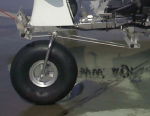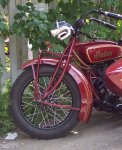EdL
Comm Rotor Gyro, ASEL
- Joined
- Feb 11, 2018
- Messages
- 144
- Location
- Lakeway, TX
- Aircraft
- Magni M-16, Piper Warrior
- Total Flight Time
- 1300
Sorry, WaspAir - got distracted yesterday and handled some of these out of sequence. I'm sure you've been waiting for my reply :biggrin:
OK - as described, that doesn't sound too outrageous - and also sounds like it's only possible as described for relatively small amounts of demonstrated crosswind. And there's a difference between a 20kt wind from 30 degrees off the runway and 10 kt from 90 degrees: both give a demonstrated crosswind component of 10kts but turning 30 degrees into the first makes it pure headwind while turning 30 degrees into the 90 degree one still gives you most of that 10kts to still deal with, so one still needs to manage that, and now on a shorter effective runway because of the turn.
Actually, I'd hardly call the procedure published in the FAA's handbook, as cited by Vance, the "cowboy maneuver". And again, unless one is truly able to point directly into the wind, one still must deal with a crosswind - by the "cowboy maneuver".
First, remember that's the design limit of the gyro - not the proficiency of the pilot. Second, while I'm not sure I've actually landed in 25kts of demonstrated crosswind, I can definitely say there have been days where I've looked at the windsock out my window and said there's no way I'd take my Warrior up but have gone up with the gyro with no problem at all. We have houses on the west side, so winds from the west give us some un-cool burbles right when you get to the runway, which is always sporting in the Warrior. By contrast, I was surprised at how little they're felt in the Magni, even when "air taxiing"/"landing long" for 2000 feet of the runway at 2-3 feet off the deck and 65mph. And, once again, with your technique you're either still needing to slip or you're turning up to 90 degrees to the runway.
Incidentally, take a look on Google Maps at Lakeway Airpark and see if you'd be comfortable landing 90 degrees on a "taxiway". Maybe so, but the locals would ensure it only happened once...
As to the “crabbing” comment, crabbing is an integral part of flying for every airman except balloonists. It’s a lot quicker to say than “wind correction angle” and is a concept to be understood and mastered through all phases of flight - takeoff roll to touchdown. “Remember how we had to crab to get our ground track out to the practice area to be what we wanted? And remember how we compensated for wind during S-turns? It’s the same issue here in the pattern”.
One other thing: I do keep an approach speed as close to 65mph as possible pretty much for every landing (as per the Magni book). Touchdown speed is indeed much, much less (as close to zero as practical). Two big reasons: first, the more air over the rudder, the more rudder authority one has. Second, a go-around at 65 is a non-event; a go-around at 20mph is scary at best and often not possible. One is progressively reducing options as one goes from 65 to 20. Also, I most definitely keep my approach speed up when it's gusty; inertia is your friend in those cases.
/Ed
WaspAir;n1142523 said:No, you're apparently picturing a long skewed final approach over houses and hangars that nobody here is advocating. The diagonal path limits only the on-pavement rolling to 120 feet and then only if you don't have any taxiways to aim for, but even so that's not quite the same thing as having a tiny airport with only a 120 foot runway. You still have a broad open area of airport over which to do all your approaching and descending. You can fly your final in full coordination with a wind correction angle in your heading (I hate the term crab, because it improperly suggests uncoordinated yawing to many) just on the downwind side, until lined up for your touchdown path, when you adjust slightly to point parallel to the windsock and put it down with very, very little groundspeed and no need for more rolling distance (and certainly no risk to houses and hangars). If the wind is significant enough to require that correction, you can have a truly small ground speed, and you will find that 120 feet is a pretty big target, while the hangars look very distant at that slow rate of closure.
There may be a perception problem here from never having seen it done, and from the specific aircraft you fly and touchdown speeds with which you are accustomed, which may be why you consider this to be a non-standard dirt-bike sort of operation. .
OK - as described, that doesn't sound too outrageous - and also sounds like it's only possible as described for relatively small amounts of demonstrated crosswind. And there's a difference between a 20kt wind from 30 degrees off the runway and 10 kt from 90 degrees: both give a demonstrated crosswind component of 10kts but turning 30 degrees into the first makes it pure headwind while turning 30 degrees into the 90 degree one still gives you most of that 10kts to still deal with, so one still needs to manage that, and now on a shorter effective runway because of the turn.
WaspAir;n1142523 said:From my perspective, using the slip technique instead is the cowboy maneuver, needlessly risking control loss, runway excursions, rollovers, and such.
Actually, I'd hardly call the procedure published in the FAA's handbook, as cited by Vance, the "cowboy maneuver". And again, unless one is truly able to point directly into the wind, one still must deal with a crosswind - by the "cowboy maneuver".
WaspAir;n1142523 said:Personally, I find a 25 kt. demonstrated crosswind component to be nothing short of silly for a gyroplane. If the wind is that strong, I can always land with zero roll by just pointing into it. Nobody will care about your orientation to the pavement if you're not moving on it, and you won't be thought a madman for using minimal runway.
First, remember that's the design limit of the gyro - not the proficiency of the pilot. Second, while I'm not sure I've actually landed in 25kts of demonstrated crosswind, I can definitely say there have been days where I've looked at the windsock out my window and said there's no way I'd take my Warrior up but have gone up with the gyro with no problem at all. We have houses on the west side, so winds from the west give us some un-cool burbles right when you get to the runway, which is always sporting in the Warrior. By contrast, I was surprised at how little they're felt in the Magni, even when "air taxiing"/"landing long" for 2000 feet of the runway at 2-3 feet off the deck and 65mph. And, once again, with your technique you're either still needing to slip or you're turning up to 90 degrees to the runway.
Incidentally, take a look on Google Maps at Lakeway Airpark and see if you'd be comfortable landing 90 degrees on a "taxiway". Maybe so, but the locals would ensure it only happened once...
As to the “crabbing” comment, crabbing is an integral part of flying for every airman except balloonists. It’s a lot quicker to say than “wind correction angle” and is a concept to be understood and mastered through all phases of flight - takeoff roll to touchdown. “Remember how we had to crab to get our ground track out to the practice area to be what we wanted? And remember how we compensated for wind during S-turns? It’s the same issue here in the pattern”.
One other thing: I do keep an approach speed as close to 65mph as possible pretty much for every landing (as per the Magni book). Touchdown speed is indeed much, much less (as close to zero as practical). Two big reasons: first, the more air over the rudder, the more rudder authority one has. Second, a go-around at 65 is a non-event; a go-around at 20mph is scary at best and often not possible. One is progressively reducing options as one goes from 65 to 20. Also, I most definitely keep my approach speed up when it's gusty; inertia is your friend in those cases.
/Ed







